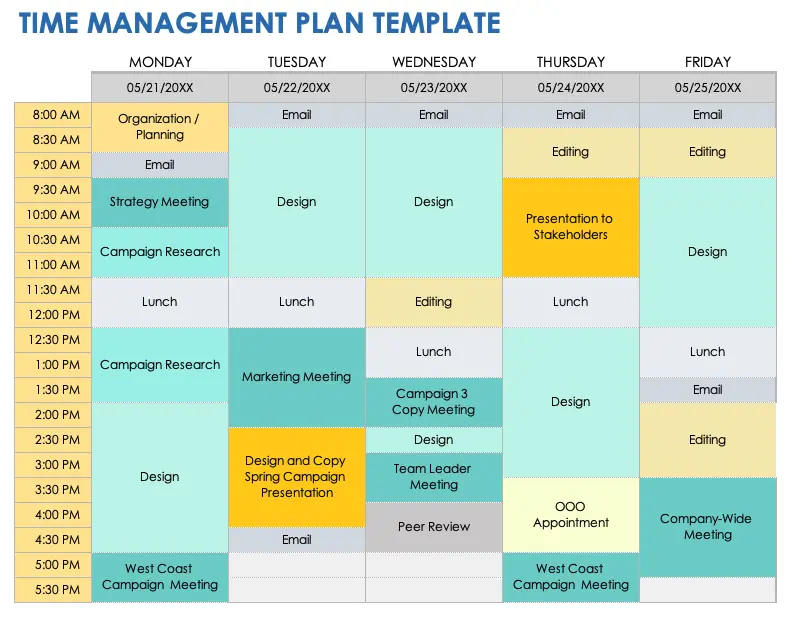Achieve More, Stress Less – Business Owners Time Management Tips

Business Time Management: Do you ever feel like there just aren’t enough hours in the day? Maybe you’ve found yourself juggling a seemingly endless to-do list, rushing from one meeting to another, and struggling to find a moment to catch your breath. If you’re a busy business professional, you’re certainly not alone in facing these challenges.
In today’s fast-paced and demanding professional world, effective time management isn’t just a skill; it’s a lifeline. It’s the key to achieving your career goals while also maintaining that elusive work-life balance we all aspire to.
Picture this: You wake up in the morning feeling calm and in control. You tackle your tasks with precision, leaving no room for stress or chaos. You have time for strategic thinking, professional development, and, most importantly, for yourself and your loved ones.
If this sounds like a dream scenario, it’s time to turn it into your reality. Welcome to our comprehensive guide on time management tools and strategies, meticulously crafted for busy business professionals like you.
We’ll delve into the art and science of effective time management. You’ll discover a treasure trove of tools, techniques, and insights to help you seize control of your schedule, enhance your productivity, and ultimately, transform your professional life.
So, whether you’re a seasoned executive, an ambitious entrepreneur, or a rising star in your industry, get ready to unlock the secrets of time management success. Our purpose is simple: to equip you with the skills and knowledge you need to conquer your calendar and achieve professional greatness. Let’s dive in.
Understanding Time Management
In the relentless world of business, time management isn’t just a buzzword; it’s the compass guiding professionals through a maze of responsibilities and opportunities.
Defining Time Management
At its core, time management is the art of structuring and utilizing your time to achieve specific goals, tasks, or activities efficiently. It’s the difference between merely being busy and accomplishing what truly matters.
The Business Imperative
In a business context, the importance of time management cannot be overstated. It’s the linchpin that holds together a well-oiled machine. Poor time management can lead to missed deadlines, frazzled nerves, and a reputation for unreliability. On the flip side, mastering this art can catapult your career and business to new heights.
The High Cost of Inefficiency
Imagine missing a critical project deadline because you lost track of time in unproductive meetings or endless email chains. The consequences could be dire, ranging from financial losses to damage to your professional reputation.
Productivity: The Holy Grail
Beyond simply managing time, effective time management is intrinsically linked to productivity. It’s about accomplishing more with less effort. When you manage your time wisely, you create pockets of productivity where you can focus on high-impact tasks and bring your A-game to every project.
Common Time Management Challenges
In the fast-paced realm of business, time management challenges lurk around every corner. To navigate this landscape effectively, it’s essential to recognize and understand these common hurdles. Let’s shine a light on some of the most prevalent time management challenges business professionals face.
The Multitasking Myth
Many believe that juggling multiple tasks at once is a hallmark of efficiency. However, in reality, multitasking often leads to a decrease in productivity. It divides your attention, making it harder to focus on any single task. We’ll uncover the science behind this myth and reveal why single-tasking can be your secret weapon.
Procrastination Purgatory
Procrastination is a formidable foe in the battle for effective time management. We all have our moments of delay, but when it becomes chronic, it can wreak havoc on your schedule. We’ll explore the psychological underpinnings of procrastination and equip you with strategies to conquer it.
Technology’s Double-Edged Sword
Technology, while a boon, can also be a bane when it comes to time management. Constant notifications, emails, and the allure of social media can hijack your focus. We’ll discuss the role of technology in these distractions and ways to use it as a tool for better time management.
Over commitment Overload
Business professionals often find themselves in the trap of overcommitting. The desire to impress or fear of missing out can lead to an overwhelming schedule. We’ll explore the consequences of overcommitment and teach you how to wield the power of “no.”
Essential Time Management Tools
In your quest for effective time management, having the right tools at your disposal can be a game-changer. Here, we introduce an array of time management tools and apps meticulously crafted for busy business professionals. These digital companions will empower you to navigate the complex terrain of your workday with finesse, precision, and efficiency.
Task Management Titans
- Todoist: A versatile task manager that excels in simplicity and effectiveness. Todoist allows you to organize tasks by priority, set due dates, and even collaborate with colleagues.
- Trello: For visual thinkers, Trello is a dream come true. It uses boards, lists, and cards to help you organize tasks and projects in a visually intuitive way.
- Asana: Ideal for project management, Asana offers a suite of tools for tracking tasks, assigning responsibilities, and setting deadlines. It’s especially effective for collaborative work environments.
Scheduling Sorcery
- Google Calendar: A classic for good reason, Google Calendar keeps your schedule in check. It syncs seamlessly across devices and allows for easy event creation and sharing.
- Calendly: Simplify appointment scheduling with Calendly. Share your availability, and let others book time with you effortlessly.
- RescueTime: An eye-opening tool that tracks how you spend your digital time. RescueTime helps you identify productivity pitfalls and take corrective action.
Goal-Setting Wizards
- GoalsOnTrack: Tailored for goal setting and habit tracking, this app helps you set SMART goals and provides a roadmap to achieve them.
- Nozbe: Combining task management and goal setting, Nozbe ensures your daily tasks align with your long-term objectives.
Note-Taking Virtuosos
- Evernote: The quintessential note-taking app, Evernote allows you to organize your thoughts, ideas, and important information in a digital notebook.
- Notion: More than just note-taking, Notion is a versatile workspace that accommodates tasks, projects, databases, and more, all in one place.
Communication Commanders
- Slack: Streamline communication with your team through channels and direct messaging. Slack keeps work-related conversations organized and searchable.
- Zoom: In the era of remote work, Zoom has become the go-to tool for virtual meetings and webinars, allowing for seamless collaboration across distances.
These are just a few of the essential time management tools available to modern business professionals. Whether you’re looking to streamline your task management, enhance your scheduling prowess, or fine-tune your goal-setting skills, these tools are your trusted allies on the journey to optimal time management. Best of all, many offer free versions, making them accessible to professionals of all backgrounds and budgets. Explore these digital companions, and discover which ones best complement your time management style.

Strategies for Effective Time Management
Now that we’ve dissected the challenges, it’s time to assemble your arsenal of time management strategies. These battle-tested techniques are the tools you need to conquer the chaos and make every minute count in your professional life.
The Pomodoro Technique: Unleashing Laser-Like Focus
In the battlefield of time management, the Pomodoro Technique stands as a formidable secret weapon—a technique celebrated for its ability to enhance concentration, banish distractions, and maintain peak performance throughout the workday.
Imagine this: you’re armed with a timer, and you set it for a focused, uninterrupted work sprint of 25 minutes. During this time, your sole mission is the task at hand. No email notifications, no side conversations—just a relentless focus on your work. When the timer rings, you grant yourself a 5-minute breather. It’s during this short break that you recharge, stretch, and mentally prepare for your next Pomodoro. After completing four Pomodoros, reward yourself with a more extended break, say, 15 to 30 minutes.
This structured approach to work, punctuated by these time intervals, is the essence of the Pomodoro Technique. By adhering to this method, you’ll experience a remarkable transformation in your productivity. You’ll not only accomplish tasks more efficiently but also find your workday unfolding with a newfound sense of purpose and order.
Time Blocking: Sculpting Your Ideal Day
Do you ever wish for more hours in a day? While we can’t bend the laws of time, we can certainly make the most of the hours we have. This is where the art of time blocking comes into play—a strategy that empowers you to seize control of your schedule.
Time blocking is a masterful approach to allocating specific periods for designated tasks, activities, or meetings. It’s your personal chisel for sculpting your ideal day. No longer will you drift aimlessly through your schedule, reacting to the whims of your inbox or the demands of others.
In this section, we’ll guide you through the intricacies of time blocking. You’ll learn how to carve out dedicated blocks of time for essential work, meetings, deep focus, and even personal time. The result? A day that aligns with your priorities, fosters productivity, and leaves you feeling accomplished, not overwhelmed.
Setting SMART Goals: The Roadmap to Success
Goal-setting is the compass that guides you through the vast terrain of time management. However, not all goals are created equal. That’s where the SMART criteria come into play—Specific, Measurable, Achievable, Relevant, and Time-bound.
We’ll take you through each element of SMART goal-setting, showing you how to craft objectives that are laser-focused on what truly matters. Specific goals provide clarity and direction, while measurable ones allow you to track progress. Achievable goals are within your reach, and relevant ones align with your broader objectives. Finally, time-bound goals introduce a sense of urgency.
Armed with SMART goals, you’ll possess a roadmap that not only steers your professional journey but also serves as a beacon for effective time management. No longer will your efforts scatter in various directions; instead, they’ll coalesce into a formidable force propelling you toward your goals.
Prioritization and Delegation: The Keys to Efficiency
Efficiency in time management hinges on two essential strategies: prioritization and delegation.
Prioritization is the art of identifying your most critical tasks and tackling them head-on. In a world teeming with distractions and demands, understanding what truly matters is paramount. We’ll guide you through the process of discerning your top priorities, ensuring that your efforts are channeled where they’ll make the most significant impact.
Delegation, on the other hand, is the skill of entrusting tasks to others. In a professional landscape marked by collaboration, delegation can be your secret weapon. We’ll explore the delicate balance of when to delegate and how to empower your team to take ownership of their responsibilities. By sharing the load strategically, you’ll not only free up precious time but also foster a culture of shared success within your organization.
These strategies are the building blocks of effective time management, and in the following sections, we’ll delve even deeper into their practical application. It’s time to equip yourself with these powerful tools and strategies to reclaim control over your time and professional destiny.
Integrating Time Management into Workflows
Imagine having time management work for you, not against you. In this section, we’ll explore the art of seamless integration, where time management becomes a natural part of your daily workflow.
Incorporating Time Management Tools
One of the first steps in integrating time management into your workflow is choosing and effectively using the right tools. Whether you’re an advocate for digital solutions or prefer the tactile feel of pen and paper, selecting the appropriate tools can significantly impact your time management success.
- Calendar Apps: Dive deeper into the world of calendar apps and discover advanced features that can supercharge your scheduling. Learn how to set reminders, create shared calendars for teams, and make the most of features like time blocking.
- Task Managers: We’ll explore task management software beyond the basics. Discover how to use tags, labels, and advanced filtering options to categorize and prioritize tasks effectively.
- Time Tracking Software: If you’re keen on optimizing your time, time tracking software can be a game-changer. Explore how to use these tools to identify time sinks, improve focus, and fine-tune your daily routines.
- Email Management: Email can be a notorious time drain. Learn email management techniques that allow you to maintain a tidy inbox, automate repetitive tasks, and respond more efficiently.
Setting Up Routines and Habits
Effective time management isn’t just about following a to-do list; it’s about establishing sustainable habits that promote productivity. In this subsection, we’ll delve into the creation of routines tailored to your work style:
- Morning Rituals: Discover the power of a well-structured morning routine. We’ll explore techniques for starting your day with intention, setting priorities, and optimizing your energy levels.
- Planning Rituals: Effective planning is the cornerstone of time management. Learn how to create daily, weekly, and monthly planning rituals that keep you focused on your goals and priorities.
- Daily Review: The day’s end is as crucial as its beginning. We’ll discuss daily review practices that help you reflect on your accomplishments, identify areas for improvement, and set the stage for a productive tomorrow.
The Benefits of a Well-Structured Work Environment
Your physical and digital workspace profoundly influences your ability to manage time effectively. A cluttered and disorganized environment can lead to distractions and inefficiencies. In this part, we’ll explore workspace optimization:
- Decluttering: Discover the art of decluttering your physical workspace. We’ll provide step-by-step guidance on how to reduce distractions, improve focus, and create a more productive atmosphere.
- Digital Organization: Your digital workspace is just as important. Learn techniques for organizing your digital files, emails, and applications for quick and easy access.
- Ergonomics: Understand the significance of ergonomics in maintaining productivity and reducing the risk of burnout or physical strain in your workspace.
Case Studies and Success Stories
Real-world success stories are more than just inspiration; they’re evidence that effective time management is not an elusive concept but a tangible skill that can be mastered. In this section, we’ll introduce you to notable individuals who have not only mastered the art of time management but have also left a significant mark in their respective fields.
1. Elon Musk’s Time Blocking Mastery
Elon Musk, the visionary CEO of SpaceX and Tesla, is synonymous with audacious projects and relentless schedules. But what’s his secret to managing it all? The answer lies in a meticulously structured technique known as time blocking.
In this exploration of Musk’s time management prowess, we delve deep into the world of Elon’s schedule. He doesn’t just allocate his day; he micro-manages it, dividing it into five-minute slots. We’ll dissect this approach, revealing how every precious minute is dedicated to a specific task or meeting.
The Five-Minute Game Plan
For Elon Musk, time blocking isn’t a vague concept; it’s a granular game plan. His day starts early, often by 7:00 AM, and from there, it’s a series of five-minute slots.
Consider the implications of such precision. A typical meeting isn’t scheduled for an hour; it’s designated for 15 minutes or less. This approach ensures that discussions remain concise, decisions are made swiftly, and there’s no room for unnecessary elaboration.
The Power of Focus
Musk’s time blocking isn’t just about efficient scheduling; it’s a testament to the power of focus. By dedicating specific time slots to particular tasks, he minimizes context-switching, which can be a significant drain on productivity.
Imagine the productivity boost of immersing yourself completely in a task for a solid 30 minutes or an hour. This intensity of focus allows Musk to tackle complex engineering challenges at SpaceX, review Tesla’s strategic initiatives, and handle numerous other responsibilities with unparalleled efficiency.
Zero Idle Time
Perhaps the most striking aspect of Musk’s time blocking technique is its commitment to zero idle time. There’s no “waiting for the next meeting” or “killing time.” If a meeting ends early, Musk moves straight on to the next task or activity without hesitation.
This approach is a stark departure from the traditional notion of workdays peppered with coffee breaks and idle chatter. It’s a blueprint for a hyper-productive work ethic where every minute is a valuable resource.
The Multi-Tasking Myth
You might wonder if such a rigid schedule promotes multitasking. In reality, Musk is a staunch advocate for single-tasking. Each five-minute slot is a dedicated block of time for one specific task or meeting. This unwavering focus is a driving force behind his ability to lead multiple groundbreaking companies simultaneously.
Applying Musk’s Principles
While not everyone needs to be as regimented as Elon Musk, there’s much to be learned from his approach to time management. By adopting elements of time blocking, such as scheduling shorter and more focused meetings or dedicating specific blocks of time to critical tasks, you can supercharge your own productivity.
Musk’s method is a testament to what can be achieved when time is managed with military precision. It’s an approach that has allowed him to revolutionize space exploration, reshape the automotive industry, and push the boundaries of technology. By taking inspiration from his time blocking mastery, you can unlock your own potential for success and innovation.
2. J.K. Rowling’s Priority Management Wizardry
J.K. Rowling, the literary genius behind the globally beloved Harry Potter series, is not just known for her magical storytelling but also for her remarkable ability to manage her time effectively. What makes her story even more extraordinary is that she crafted this epic literary world while juggling the demands of single motherhood. The secret to her success? Priority management.
In this enchanting journey into Rowling’s time management sorcery, we’ll unveil the techniques she employed to navigate her busy life and bring the wizarding world to life.
The Power of Clear Priorities
At the heart of J.K. Rowling’s time management strategy is the unwavering focus on clear priorities. Rowling knew that to accomplish her dream of writing the Harry Potter series, she needed to prioritize her time and efforts. She famously used her daughter’s nap times to write, making the most of those precious moments.
Structured Writing Rituals
Rowling’s dedication extended to structured writing rituals. She understood that consistency was key to making progress on her novel. To achieve this, she established a routine. Every morning, she would take her baby daughter for a walk in the stroller until she fell asleep. Then, she would rush to her favorite cafe to write. This daily ritual allowed her to make steady progress on her book.
Turning Challenges into Inspiration
Rowling’s life wasn’t without its challenges. As a struggling single mother, she faced financial hardships and emotional stress. However, instead of letting these challenges hinder her progress, she used them as a wellspring of inspiration for her writing. The themes of resilience, friendship, and facing adversity head-on, which are prominent in the Harry Potter series, were drawn from her own experiences.
The Magic of Determination
Rowling’s journey to becoming a successful author wasn’t without its setbacks. She faced multiple rejections before finding a publisher for her first book. However, her determination never wavered. She continued to persevere, believing in her story and her ability to bring it to the world. This determination, coupled with effective priority management, ultimately led her to literary stardom.
Lessons from Rowling’s Wizardry
J.K. Rowling’s story is a testament to what can be achieved through effective time and priority management. By setting clear priorities, establishing structured routines, drawing inspiration from challenges, and maintaining unwavering determination, she transformed her dream into a global phenomenon.
While we may not all be writing the next great literary saga, we can certainly apply Rowling’s principles to our own lives. Whether you’re managing a career, a family, or your personal aspirations, the magic of priority management can help you accomplish your goals and create your own story of success.
3. Frank Lloyd Wright’s Time-Efficient Design
Frank Lloyd Wright, the iconic architect renowned for his groundbreaking designs, possessed not only a genius for creating awe-inspiring structures but also a remarkable mastery of time management. His unique approach to both his physical surroundings and daily routines serves as an intriguing case study in optimizing creative output and time utilization. In this exploration of Frank Lloyd Wright’s time-efficient design philosophy, we uncover how his architectural principles seamlessly extended into the realm of time management.
Architecture That Nurtured Efficiency
One cannot discuss Frank Lloyd Wright’s time management without delving into his architectural creations, which themselves were a testament to efficient design. Wright’s meticulously crafted workspaces, including his famed home and studio in Oak Park, Illinois, were meticulously designed not only for their aesthetic appeal but also for their functionality.
Wright believed that a well-designed environment could enhance productivity and creativity. His studio, for instance, featured strategically placed workspaces flooded with natural light, ensuring that he could work at any hour. This architectural ingenuity allowed him to maximize his work hours and harness the benefits of natural light, which he believed influenced his creativity.
Design Principles Applied to Daily Routines
Wright’s commitment to efficient design didn’t stop at his drafting tables. He applied his principles to his daily routines, ensuring that his time was optimized for creativity and productivity. One notable aspect of his routine was his dedication to regular, uninterrupted work periods. He believed in immersing himself in his projects for extended stretches, allowing him to reach a state of flow where his creative juices flowed freely.
Additionally, Wright recognized the importance of maintaining a well-organized workspace. His desk was meticulously organized, with every tool and material in its designated place. This dedication to tidiness allowed him to avoid the time-wasting frustration of searching for misplaced items.
Lessons from Wright’s Time-Efficient Design
Frank Lloyd Wright’s approach to time management, rooted in architectural principles, offers valuable lessons for anyone seeking to enhance their own productivity and creativity. By creating an environment that fosters efficiency, prioritizing uninterrupted work periods, and maintaining a well-organized workspace, we can adopt elements of Wright’s time-efficient design philosophy into our daily lives.
While we may not all be architects, we can certainly apply the principles of efficient design to our routines, workspaces, and lives. By doing so, we can optimize our time utilization and, just like Frank Lloyd Wright, create masterpieces of our own.
4. Marie Kondo’s Time-Saving Simplicity
Marie Kondo, the world-renowned organizer and author of “The Life-Changing Magic of Tidying Up,” has not only transformed cluttered homes but has also quietly revolutionized time management through her philosophy of simplicity and decluttering. While she’s widely known for helping people organize their physical spaces, her KonMari method extends beyond that – it encompasses time management as well. In this exploration of Marie Kondo’s time-saving simplicity, we’ll delve into her philosophy of prioritizing tasks that “spark joy” and how it can effectively streamline your daily schedule, giving you more time for the things that truly matter.
A Philosophy of Joyful Prioritization
At the heart of Marie Kondo’s approach is the idea of surrounding yourself with items that bring you joy. This principle extends to time management, where she encourages us to prioritize tasks and commitments that also “spark joy” in our lives. Rather than being dragged down by endless to-do lists and obligations, Kondo suggests that we carefully curate our schedules to include only those activities that align with our values and passions.
Streamlining Your Daily Schedule
Applying the KonMari method to time management means taking a hard look at your daily schedule and identifying activities that may not be truly fulfilling or necessary. It’s about decluttering your calendar in the same way you would declutter your home.
Start by listing all your regular activities, commitments, and tasks. Then, ask yourself whether each one truly brings you joy or aligns with your long-term goals. If an activity doesn’t spark joy or contribute meaningfully to your life, consider whether it can be eliminated or delegated to someone else.
The Art of Saying “No”
One of the most powerful lessons from Marie Kondo’s time-saving simplicity is the art of saying “no” graciously. She encourages us to decline commitments that don’t align with our values or bring us joy. By doing so, we free up time and mental energy for activities that truly matter.
This philosophy isn’t about avoiding responsibilities; it’s about consciously choosing how to spend your time based on what brings you fulfillment. It’s a practice in setting boundaries and being intentional about where you invest your precious hours.
The Joy of Time Well-Spent
Marie Kondo’s approach to time management teaches us that life is too short to be spent on activities that don’t bring us joy or fulfillment. By applying the KonMari method to our daily schedules, we can declutter our lives of unnecessary busyness and create more room for the things that truly matter – spending time with loved ones, pursuing our passions, and savoring the moments that bring us genuine happiness.
In a world often obsessed with productivity and constant busyness, Marie Kondo’s time-saving simplicity reminds us that the true art of time management is in savoring the joy of time well-spent.
5. Steve Jobs’ Focus on Prioritization
Steve Jobs, the visionary co-founder of Apple Inc., was not only known for his groundbreaking innovations but also for his exceptional ability to focus on what truly mattered. Central to his time management philosophy was the use of the “Eisenhower Matrix,” a simple yet powerful tool for prioritization. Jobs applied this method to categorize tasks into four distinct quadrants: urgent, important, less important, and unnecessary. This strategic approach allowed him to allocate his time and energy efficiently, resulting in the creation of revolutionary products like the iPhone and iPad. In this exploration of Steve Jobs’ focus on prioritization, we’ll delve into how you can adapt this method to enhance your own professional life.
The Eisenhower Matrix: A Framework for Prioritization
The Eisenhower Matrix, also known as the Urgent-Important Matrix, was named after Dwight D. Eisenhower, the 34th President of the United States, who emphasized the importance of tasks’ urgency and significance. Jobs recognized the value of this framework and applied it rigorously in his daily routines.
Here’s a breakdown of the four quadrants in the Eisenhower Matrix:
- Urgent and Important: Tasks in this quadrant demand immediate attention and are of significant importance. They are your top priorities, and Jobs referred to them as “Do First” tasks.
- Important, but Not Urgent: Tasks in this quadrant are crucial for long-term success but don’t require immediate action. These are your “Schedule” tasks, which you should plan for and tackle systematically.
- Urgent, but Not Important: Tasks in this quadrant appear pressing but lack significant long-term impact. They often involve distractions or interruptions and should be minimized. Jobs labeled these tasks as “Delegate” or “Eliminate” if possible.
- Not Urgent and Not Important: Tasks in this quadrant are neither pressing nor essential. They are time-wasters and should be avoided. Jobs called these tasks “Don’t Do.”
Applying the Matrix to Your Professional Life
To harness the power of Steve Jobs’ prioritization strategy, begin by categorizing your tasks into the four quadrants. This simple exercise can provide clarity on what truly needs your attention and what can be deferred or eliminated. Here’s how to get started:
- List Your Tasks: Begin by listing all the tasks on your to-do list or in your project management system.
- Assign Quadrants: Assess each task and assign it to one of the four quadrants based on its urgency and importance.
- Focus on Quadrant 1: Jobs emphasized tackling tasks in Quadrant 1 (Urgent and Important) first. These are your immediate priorities.
- Plan for Quadrant 2: Allocate time for tasks in Quadrant 2 (Important, but Not Urgent) to ensure you’re working on long-term goals.
- Minimize Quadrant 3: Reduce tasks in Quadrant 3 (Urgent, but Not Important) through delegation or elimination.
- Avoid Quadrant 4: Steer clear of tasks in Quadrant 4 (Not Urgent and Not Important) to save time and maintain focus.
The Jobsian Approach to Time Management
Steve Jobs’ relentless pursuit of excellence and innovation was underpinned by his ability to prioritize effectively. By adopting the Eisenhower Matrix and focusing on tasks that truly mattered, he directed his energy towards game-changing products that transformed entire industries.
By applying this approach to your professional life, you can elevate your productivity, concentrate on what truly counts, and achieve your own remarkable feats. Steve Jobs’ focus on prioritization is a timeless lesson in the art of managing time for maximum impact.
These case studies are windows into the time management strategies of prominent figures from diverse fields. By distilling their methods and lessons, you can adopt strategies that resonate with your own life and work. Whether you’re an entrepreneur, writer, architect, or designer, these stories provide valuable insights to help you optimize your time and channel your efforts towards your most meaningful goals.
Personalized Time Management Plans
Effective time management isn’t one-size-fits-all; it should align with your unique needs and aspirations. In this section, we’ll help you tailor your own time management plan for optimal results.
Self-Assessment for Insight: Begin by looking inward. Reflect on your current time management practices. Are there recurring patterns? Identify time-wasting habits and areas where improvement is needed. This self-awareness is the first step towards more efficient time management.
Defining Your Priorities: Determine your short-term and long-term goals, both in your professional and personal life. Understanding what truly matters to you will guide your time allocation. Remember, effective time management isn’t about doing more; it’s about doing what matters most.
SMART Goals: Familiarize yourself with the SMART criteria—Specific, Measurable, Achievable, Relevant, and Time-Bound. Apply these principles to your goals to make them more actionable and attainable.
Time Blocking Techniques: Explore time blocking techniques like those used by Elon Musk. Allocate specific time slots for tasks, meetings, and breaks. This structured approach can enhance focus and productivity.
Task Prioritization: Implement methods such as the Eisenhower Matrix to categorize tasks by urgency and importance. This will help you identify high-impact activities that deserve your immediate attention.
Calendar and Apps Integration: Leverage digital tools and apps that integrate with your calendar. These tools can send reminders, automate routine tasks, and streamline your workflow.
Tools, Templates and Worksheets
To assist you in creating your personalized time management plan, we’ve included templates and worksheets. These resources will guide you through the process, allowing you to document your goals, priorities, and daily schedules.
1. Toggl Plan

Price: Starting at just $9/month
In a world where efficient time management is paramount, Toggl Plan emerges as a comprehensive project and resource management tool. It caters to both companies and individuals, offering a unique approach to overcoming productivity challenges, optimizing workloads, and avoiding burnout. Beyond these benefits, it has the power to enhance profitability, making it a versatile choice for professionals in various domains.
While Toggl Plan might not be a conventional time management tool, it boasts features that can significantly aid in effective time utilization. Notable among these features are the timelines and time tracking integration. These elements enable users to gain invaluable insights into their time allocation, fostering better time management practices.
What Sets Toggl Plan Apart?
- Drag-and-Drop Timelines and Boards: Toggl Plan simplifies the process of visualizing and organizing your team’s time. With its user-friendly drag-and-drop interface, you can effortlessly manage your schedules and tasks, significantly boosting overall productivity.
A Missing Piece
One point to note is that Toggl Plan does not offer a dedicated time tracker. However, it seamlessly integrates with Toggl Track, a sister application that provides comprehensive time tracking capabilities. While some users appreciate this modular setup, others may prefer a consolidated tool that combines project planning and time tracking in one.
Ideal User Profile
Toggl Plan finds its niche among knowledge-based service businesses seeking a straightforward, user-friendly tool to enhance their time management practices. If you value simplicity and efficiency, Toggl Plan could be your ideal ally.
Key Features at a Glance
- Drag-and-Drop Timelines: Effortlessly visualize and organize your team’s schedules and tasks to supercharge productivity.
- Time Tracking: Effective time management hinges on understanding how time is spent. Toggl Plan’s seamless integration with Toggl Track provides those crucial insights.
- Resource Planning: Gain a comprehensive overview of your team’s capacity, facilitating seamless resource allocation and balance.
- Task Management: Achieve faster task completion with visually-enhanced project and team timelines.
- Real-Time Collaboration: Foster seamless communication and project-related sharing among team members in real time.
Tool Integrations
Toggl Plan integrates seamlessly with a range of essential tools, including Toggl Track, Slack, and Google Calendar.
Pricing Tailored to Your Needs
Toggl Plan offers three distinct pricing plans:
- Free: Ideal for solo users looking to optimize their time management.
- Team ($9/user/month): Tailored for medium-sized teams seeking efficient project and resource management.
- Business ($15/user/month): Designed to meet the needs of larger teams and businesses, ensuring effective time management across the board.
In a world where time is a valuable currency, Toggl Plan stands as a valuable ally, empowering you to make every moment count and maximize your efficiency, all while maintaining a budget-friendly approach.
2. Todoist

Price: Starting at just $5/month
In the realm of efficient time management, Todoist emerges as a renowned task management application. It’s a dynamic tool designed to help you seize control of your time, and by extension, your life.
Todoist simplifies task management, empowering users to enhance their time utilization. With features like task creation, reminders, due dates, and labels, it streamlines organization and amplifies productivity, ensuring that no precious minute goes to waste.
Distinctive Advantages of Todoist
- User-Friendly Simplicity: Todoist boasts a straightforward interface that facilitates effortless task management. It’s a tool that prioritizes user ease, allowing you to work smarter and faster.
Identifying the Gap
Todoist, while remarkable, lacks resource management and project planning features. These omissions can be significant in optimizing time management to the fullest extent. If you require these elements in your time management toolkit, it might be beneficial to consider complementary tools.
Tailored for Whom?
Todoist is ideal for individuals and teams seeking a no-frills task management solution to enhance their time management practices. If simplicity and efficiency are your watchwords, Todoist is poised to become your trusted ally.
Key Features at a Glance
- Robust Task Management: Flexibly manage tasks, ensuring optimal productivity.
- Productivity Tools: Todoist enables you to set reminders and notifications for crucial deadlines, ensuring timely project completion.
- Natural Language Processing: From due dates to recurring tasks, Todoist possesses an intuitive understanding of your workflow, allowing you to concentrate on what truly matters.
- Team Collaboration: Real-time connectivity with your team ensures seamless communication and timely project deliveries.
Seamless Tool Integrations
Todoist seamlessly integrates with vital tools such as Google Calendar, Gmail, and Slack, further streamlining your workflow.
Pricing That Adapts to Your Needs
Todoist offers four distinct pricing plans:
- Beginner Plan ($0): Ideal for individuals looking to keep tabs on their tasks and responsibilities.
- Pro Plan ($5/user/month): Tailored for those managing tasks and projects for their teams.
- Starter Plan ($0): Suited for small-scale project management.
- Business Plan ($8/user/month): Crafted for collaborative teams seeking to optimize their processes.
In the dynamic landscape of modern life and work, where every second counts, Todoist serves as a valuable ally. It empowers you to seize control of your time, work more efficiently, and unlock the potential for greater productivity, all while offering budget-friendly pricing plans.
3. Time Management Plan Template

Use this time management plan template to outline an effective strategy for managing your time and achieving your goals. The template features day-by-day columns for scheduling tasks, meetings, breaks, and other activities in half-hour increments. With its user-friendly design, this template empowers individuals and organizations to optimize their time and resources, enabling them to accomplish their objectives efficiently and maximize their productivity.
By tailoring your time management plan to your specific circumstances and objectives, you’ll unlock the full potential of your productivity. Remember, the most effective plan is one that aligns with your unique goals and lifestyle.
Tips for Sustained Time Management Improvement
Congratulations on taking the steps to enhance your time management skills. But the journey doesn’t end here; it’s an ongoing process. In this section, we’ll explore strategies to sustain and continually enhance your time management proficiency.
- Embrace Adaptability and Flexibility: Life is dynamic, and so are your responsibilities. Be ready to adapt your time management strategies when circumstances change. If a new project arises or your priorities shift, adjust your plan accordingly.
- Continuous Learning: Just as you invest time in managing your tasks, invest in learning more about time management itself. Attend workshops, read books, or take online courses on productivity and time management techniques. Learning from experts and peers can offer fresh insights.
- Data-Driven Decision-Making: Use data and analytics to monitor your time management progress. There are various time tracking apps and software available that can provide insights into how you spend your time. Analyzing this data can help you identify areas for improvement and optimize your routines.
- Seek Feedback: Don’t hesitate to seek feedback from colleagues, mentors, or coaches. They can provide valuable insights into your time management blind spots and suggest strategies for improvement.
- Continuous Goal Setting: Keep setting SMART goals for yourself. Regularly review and update them to ensure they remain aligned with your evolving priorities.
- Delegate When Necessary: As your responsibilities grow, it may become essential to delegate tasks. Delegation is a valuable time management skill in itself, allowing you to focus on higher-priority activities.
- Celebrate Small Wins: Acknowledge and celebrate your achievements, no matter how minor they may seem. Celebrating small wins can boost your motivation and maintain your enthusiasm for effective time management.
- Mindfulness Practices: Incorporate mindfulness practices, such as meditation and deep breathing exercises, into your routine. These techniques can enhance your focus, reduce stress, and contribute to overall well-being, which is vital for effective time management.
- Maintain Work-Life Balance: Remember that time management isn’t just about work; it’s about managing your entire life. Ensure you allocate time for personal life, relaxation, and pursuing your passions.
By embracing adaptability, continuous learning, data analysis, and seeking feedback, you can sustain and improve your time management skills over the long term. The journey to effective time management is ongoing, but the rewards in terms of productivity, work-life balance, and personal satisfaction are well worth the effort.
Balancing Work and Life
Achieving a successful career is a commendable goal, but it should never come at the expense of your personal life and well-being. In this section, we’ll delve into the critical topic of balancing work and life, and how effective time management plays a pivotal role in achieving this equilibrium.
The Importance of Work-Life Balance
It’s not a luxury; it’s a necessity. Maintaining a healthy work-life balance is essential for your mental, physical, and emotional well-being. It helps prevent burnout, reduces stress, and enhances overall happiness.
Setting Boundaries
As a business professional, it’s crucial to set clear boundaries between work and personal life. Establish specific working hours and stick to them as closely as possible. When work hours are over, disconnect from your professional responsibilities.
Prioritize Personal Time
Just as you prioritize tasks at work, prioritize your personal time. Allocate time for activities that recharge you, whether it’s spending time with family, pursuing hobbies, or simply relaxing. Remember, personal time is an investment in your long-term productivity and happiness.
Utilize Time Management Tools
Leverage the time management tools and strategies you’ve learned earlier in this guide to maximize your work hours’ efficiency. The more productive you are during work hours, the more time you’ll have for your personal life.
Delegate and Outsource
Don’t be afraid to delegate tasks or outsource responsibilities when possible. It’s not a sign of weakness; it’s a strategic move to ensure you can focus on what truly matters in both your professional and personal life.
Reduce Stress and Prevent Burnout
Effective time management isn’t just about accomplishing tasks; it’s about reducing stress. By managing your time wisely and maintaining a work-life balance, you’ll significantly lower your risk of burnout, which can be detrimental to your career and health.
Embrace Technology Mindfully
While technology can enhance productivity, it can also blur the boundaries between work and personal life. Be mindful of the time you spend on digital devices and establish rules to limit work-related communications during your personal time.
Saying ‘No’ When Necessary
Learn to say ‘no’ to additional work or commitments when your plate is full. Overextending yourself can lead to exhaustion and negatively impact both your professional and personal life.
Seek Support
Don’t hesitate to seek support from colleagues, mentors, or a therapist if you find it challenging to balance work and life. They can provide guidance and strategies tailored to your specific situation.
Remember, achieving a healthy work-life balance isn’t a one-time accomplishment; it’s an ongoing effort. By implementing effective time management strategies, setting boundaries, and prioritizing your personal well-being, you can enjoy a successful career without sacrificing what truly matters in life. Your happiness and fulfillment depend on it.
Resources for Ongoing Learning
Learning is a lifelong journey, and when it comes to time management, there’s always room for improvement. In this section, we’ve curated a selection of resources that cater to various learning preferences, ensuring you can continue refining your time management skills long after reading this guide.
Books for In-Depth Knowledge:
- “Deep Work” by Cal Newport: Explore the concept of deep work and how it can transform your productivity.
- “Getting Things Done” by David Allen: Learn the GTD method, a comprehensive approach to managing tasks and priorities.
- “Essentialism” by Greg McKeown: Discover the art of focusing on what truly matters and eliminating the non-essential.
Online Courses and Workshops:
- Coursera’s “Learning How to Learn“: This course explores the science of learning and effective strategies for time management.
- LinkedIn Learning: Offers a variety of courses on time management, productivity, and work-life balance.
- Udemy’s “Time Management Mastery“: Dive deep into time management techniques with this comprehensive course.
Podcasts for On-the-Go Learning:
- “The Productivity Show“: This podcast delves into productivity strategies, including time management.
- “The Tim Ferriss Show”: Tim Ferriss interviews top performers and often discusses their time management habits.
- “The Life Coach School Podcast”: Explore episodes on time management, productivity, and mindset.
Websites and Blogs for Continuous Insights:
- Harvard Business Review: Offers a wealth of articles and insights on time management and leadership.
- Todoist Blog: A blog dedicated to productivity, featuring tips and strategies for effective time management.
- Zen Habits: Leo Babauta’s blog on simplicity and productivity is a treasure trove of practical advice.
TED Talks for Inspiration:
- “Inside the Mind of a Master Procrastinator” by Tim Urban: Gain insights into the procrastinator’s mind and how to combat it.
- “How to Gain Control of Your Free Time” by Laura Vanderkam: Learn how to make the most of your time, even outside of work.
- “The Power of Vulnerability” by Brené Brown: Explore the connection between vulnerability, productivity, and time management.
These resources offer a diverse range of perspectives and insights into time management. Whether you prefer to read, listen, or engage in interactive courses, there’s something here to support your ongoing learning journey. Remember, continuous improvement in time management is a path to both personal and professional success.
Your journey to mastering time management is just beginning, and your insights can inspire others. Share your own time management tips, challenges, and success stories in the comments section below. Your experiences might be the catalyst someone else needs to transform their productivity.
Don’t miss out on future updates, tips, and strategies for professional development and productivity. Subscribe to our newsletter or follow our blog for a steady stream of valuable content that will help you excel in your professional life. Your time is a valuable asset, and with the right tools and knowledge, you can make the most of every moment.

















